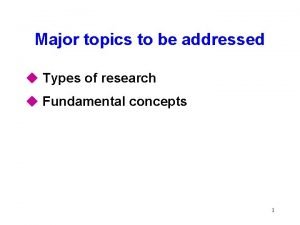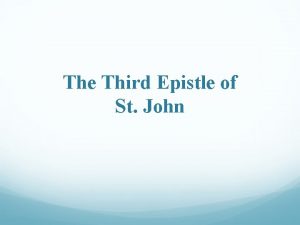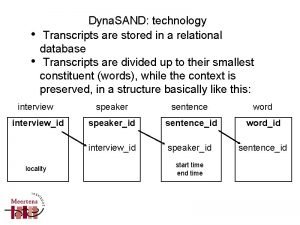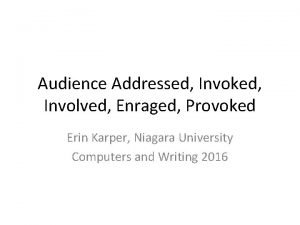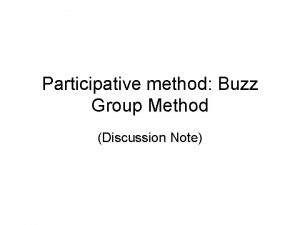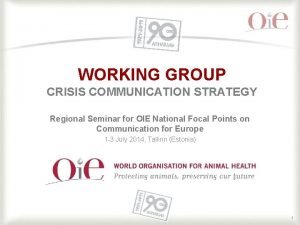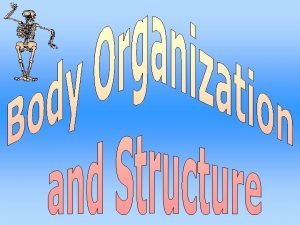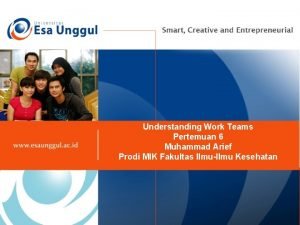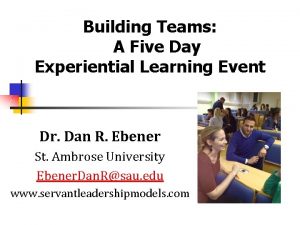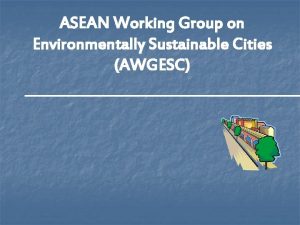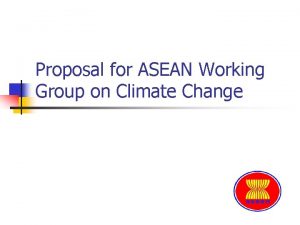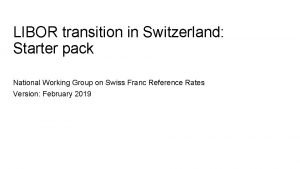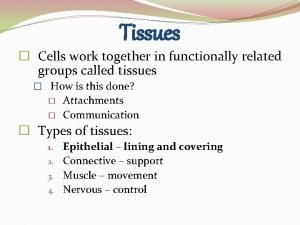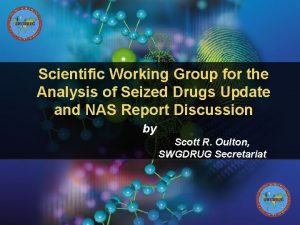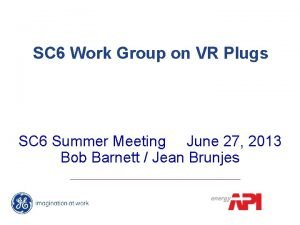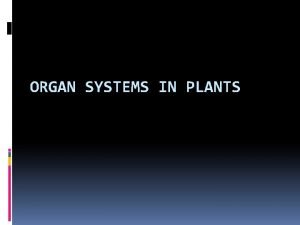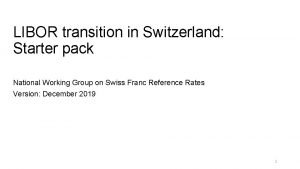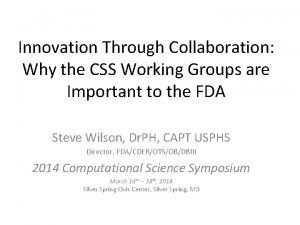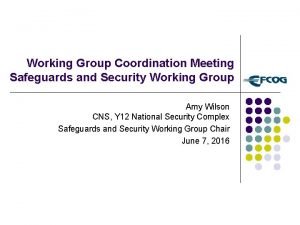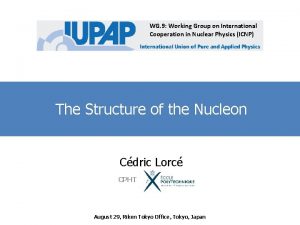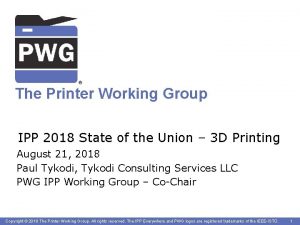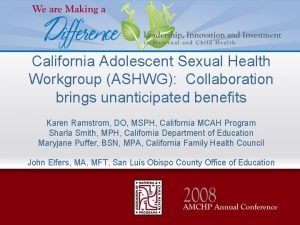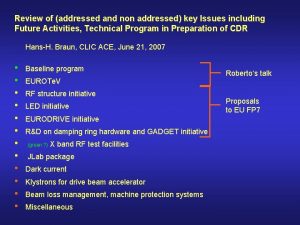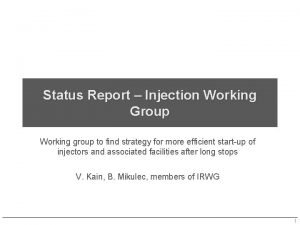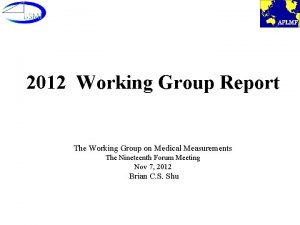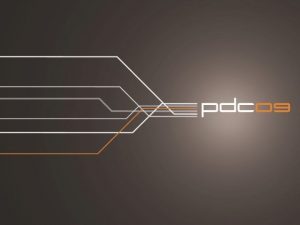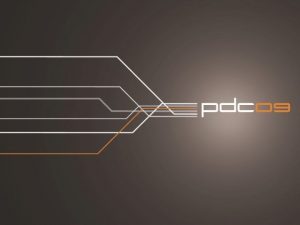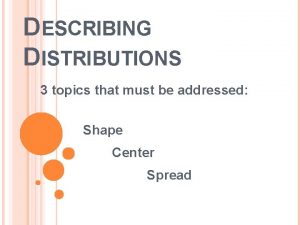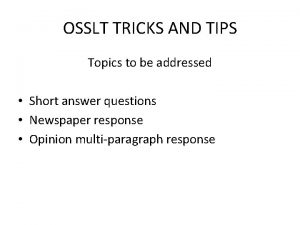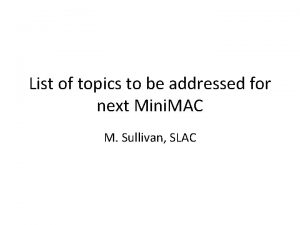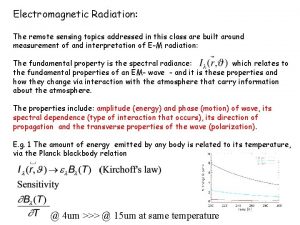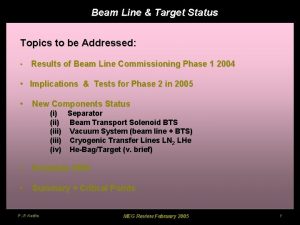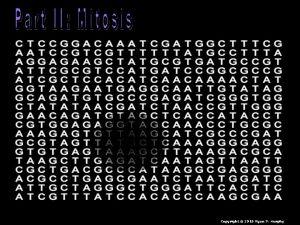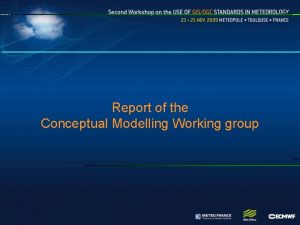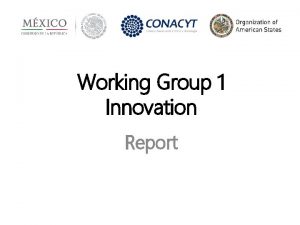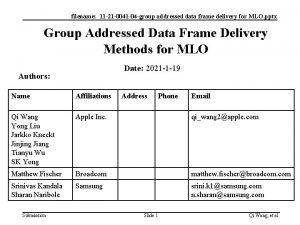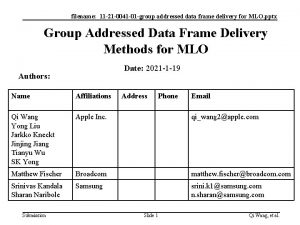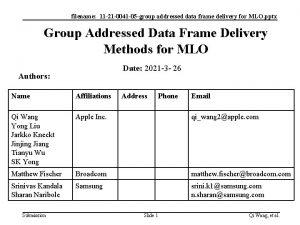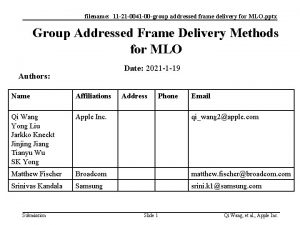Report of Working Group 2 TM44897 Topics Addressed








































- Slides: 40

Report of Working Group 2 TM-44897

Topics Addressed by WG 2 �Three topical items listed in the WG’s Terms of Reference �Eleven issues from the items tasked by the Secretariat to the WG (pages 7 and 8 of Work Plan agenda item 2. 1) �Consideration on proposal of country’s template for IAEA Share. Point �Assessment of D/DOS issues in current training material for customs and border authorities The following findings are listed according to sections / subsections of the WG 2 Report 2 Working Group 2 Report - TM-44897

Summary of D/DOS WG Findings � The WG generally did not identify any changes that might be 3 needed to the Transport Regulations as a result of D/DOS issues, recognizing that the current more comprehensive review/revision process currently underway might provide recommendations for change related to D/DOS issue. [Section 4. 1] However, it was noted that conflicts between various forms of the regulations can increase likelihood of delay or denial. � The WG recommends consideration be given to expanding the subsection in Chapter 3 of SSR-6 dealing with “Training” to also address “Education”, ensuring that all those involve in carriage of radioactive material are properly educated, focusing on each functional element in the supply chain; consideration could also be given to expanding the guidance documents reflect these changes. [Section 4. 1] Working Group 2 to Report - TM-44897

Summary of D/DOS WG Findings (Continued) � The WG recognized that a feedback process is absolutely 4 essential for the Secretariat and TRANSSC; and the basis for the changes caused by delay and denial of shipments must be effectively communicated to the CSS. [Section 4. 1] � The WG recommends that consideration could be given to writing a series of implementing guides and preparing associated training materials, similar to those being developed for security transport, structured around specific types of shipments, focusing in part on how to interact and interface with carriers, customs agencies and other entities that can cause problems with delay and denial. The development of this material should consider and take advantage of the experience and training material already Working Group 2 Report -gained TM-44897 in regional training courses (e. g. the course in Panama). [Section 4. 1]

Summary of D/DOS WG Findings (Continued) � The WG concluded that NST 022 could potentially 5 impact delay and denial in a positive, rather than negative fashion; enhancing proper transfer of information, education and understanding. [Section 4. 2] � The WG determined that neither the security of nuclear material in transport document nor the radiological crime scene management document appeared to pose any difficulties with regard to delay or denial of shipments. [Section 4. 2] � The WG recommends that, if the Action Plan is revised, the focus should be on simplification and workability. Working Group 2 Report - TM-44897 [Section 4. 3. 2]

Summary of D/DOS WG Findings (Continued) � The WG suggests that implementation of national and regional networks should give priority to the creation and/or implementation of a communication strategy. [Section 4. 3. 4] � The WG encourages the establishment of the new inter-UN agency committee for the long term and effective management of DOS issues. [Section 5] � The WG suggested that the Secretariat investigate whether changes to the radiation protection programme could be implemented to ease delays and denials without sacrificing the adequacy of radiation protection. [Section 5] 6 Working Group 2 Report - TM-44897

Summary of D/DOS WG Findings (Continued) � The WG concurred with the current transport safety work plan and recommended that it continue to be applied. [Section 6. 1] � The WG recommended consideration should be given by the Agency to sending a letter directed to all Member States encouraging Member States to become members of TRANSSC and to appoint an NFP if they have not already done so. This is significantly important since about 2/3 rd of the Member States are not members of TRANSSC. [Section 6. 2] � The WG recommends that collaborative efforts between safety and security entities within the IAEA and elsewhere should be encouraged. [Section 6. 3] 7 Working Group 2 Report - TM-44897

Summary of D/DOS WG Findings (Continued) � The WG noted that the new UN inter-agency 8 committee needs for implementing the DOS Action Plan needs to be properly structured and implemented. [Section 6. 4] � The WG further recognized that it may also be necessary to consider focusing on training of the NFPs and RCs– something that has not been accomplished in the past. [Section 6. 4] � The WG recommends that (a) the ISC review and approve the Handbook for Addressing Instances of Denial/Delays of Shipment of Radioactive Material, and then (b) a meeting be convened by the Agency to review and finalize the handbook, and recommending the method and timing of publication and issuance (possibly as a technical report of the IAEA). [Section 6. 5] Working Group 2 Report - TM-44897

Summary of D/DOS WG Findings (Continued) �The WG supports inviting the ad-hoc expanded 9 inter-agency group and TRANSSC representative to the 8 th meeting of the ISC in June 2013. [Section 6. 6] �The WG recommends that the ISC, working with the Agency and other involved agencies, explore who should be the owner of the delay/denial databases and responsible for assessment of the data. [Section 6. 7] �The WG fully supports actions needed to develop guidance for customs officials, which is especially needed in the area of radiation protection, while noting that NSNS has already Working Group 2 Report - TM-44897 issued guidance for customs and border officials.

Summary of D/DOS WG Findings (Continued) �The WG suggests that the Agency should consider convening a technical meeting to collect experience on issues relating to customs operations that have caused delays or denials in shipments. [Section 6. 8] �The WG suggests that TRANSSC take on this task as part of its Terms of Reference such that, when it is reviewing draft security documents, the issue of denial of shipments is addressed. [Section 6. 9] �The WG endorses the recommendation of the ISC with regard to the newly proposed spreadsheet process, recognizing that the process needs to Working Group 2 Report - TM-44897 10 be clarified on how to use the forms. [Section

Summary of D/DOS WG Findings (Continued) � The WG recommends that the safety and the security staff at the Agency, working together, evaluate existing training materials to ensure the information presented to participants is sufficient to address concerns and actions needed as related to safety and security issues that may accrue from a delay or denial of a shipment. [Section 6. 11] � The WG also recommends that the Secretariat work within the Agency to define the adequacy of training material for national and regional training needs and the ability of Technical Cooperation to support this effort. [Section 6. 11] 11 Working Group 2 Report - TM-44897

Summary of D/DOS WG Findings (Continued) � The WG recommends that the Secretariat must provide a detailed site map of a country and regional template for the Share. Point site, in order to define a harmonized national and regional network so that the Member States can provide feedback early in the development of the network. [Section 7] � The WG recommends that the Agency consider enhancing the training course for customs and border officials to include delay and denial of shipments. [Section 8] 12 END OF WG 2 RECOMMENDTIONS AND Working Group 2 Report - TM-44897 FINDINGS

Summary information from WG 2 Report �The following slides are extracts of discussion text findings from the WG 2 deliberations. �Reference to these can assist in providing background information on the basis of the WG 2 findings 13 Working Group 2 Report - TM-44897

Supplementary Information Extracted from WG 2 Report �The following slides are extracts of discussion text findings from the WG 2 deliberations. �Reference to these can assist in providing background information on the basis of the WG 2 findings 14 Working Group 2 Report - TM-44897

Terms of Reference Tasks – Item 1 (Section 4. 1) � What revisions to the regulations would reduce incidences of denial? �None (although conflicts between various regulations from different regulatory bodies can increase likelihood of delay or denial) �Regulatory requirements alone do not cause denial. Lack of communication and understanding contributes greatly to denial and delay of shipments. �Consideration could be given to writing a series of implementing guides � structured around specific types of shipments, � focusing in part on how to interact and interface with carriers, customs agencies and other entities that can cause problems with delay and denial. �Education activities should address the technical 15 features of the packagings, the purpose and importance of transporting the materials, the economics involved, the need for advanced communication with entities Working Group 2 etc. Report - TM-44897 involved,

Terms of Reference Tasks – Item 2 (Section 4. 2) �Review of Draft Security Requirements Documents: If implemented, could the security requirements in the documents lead to denials? b) If so, are there changes in the transport regulations that could preclude this? c) If not, the proposed security provisions that could cause difficulties in transport should be highlighted. a) 16 Working Group 2 Report - TM-44897

Terms of Reference Tasks – Item 2 (Section 4. 2) (Continued) � Review of Draft Security Requirements Documents: � Documents reviewed were: a) b) c) Security of Nuclear Material in Transport (NST 017), Radiological Crime Scene Management (NST 013), and Protection and Confidentiality of Sensitive Information in Nuclear Security (NST 022). None of these documents have a significant impact on the denial of shipments of radioactive material � NST 022 could potentially impact delay and denial; but the impact could possibly be positive rather than negative, by � assisting in the proper transfer of information � enhancing the education and understanding of those involved in a shipment chain Working Group 2 Report - TM-44897 � 17

Terms of Reference Tasks – Item 3, ISC Action Plan (Section 4. 3) �Provisions of the ISC action plan should be reviewed. Do any of the action plan provisions require changes to the regulations? �Reviewed �the milestones in the implementation of the Action Plan �the status of implementation of actions by members of the Steering Committee �Assessed multiple issues 18 Working Group 2 Report - TM-44897

Terms of Reference Tasks – Item 3, ISC Action Plan, Issue 1 (Section 4. 3. 1) � Provisions of the ISC action plan milestones and implementation by Steering Committee � The action plan permitted the identification of weaknesses and strengths that should be considered in the update of the action plan. � Need to focus on improving communication with stakeholders, potentially decreasing instances of denial and delay � enhanced communication does not affect regulatory requirements other than how communications could be enhanced via possible regulatory changes � The WG noted that subsection in Chapter 3 of SSR-6 dealing with “Training” could be expanded to better address (a) training and education rather than just training, and (b) ensuring that all those involve in carriage are properly educated, focusing on each functional element in the supply chain 19 Working Group 2 Report - TM-44897

Terms of Reference Tasks – Item 3, ISC Action Plan, Issue 2 (Section 4. 3. 1) �Review and revise, if necessary, the Action Plan �Assessed the question: “Are there provisions in the Regulations that should be considered for revision, based upon these 12 points? “ �The WG group concluded the provisions of the Action Plan do not justify changing the regulation �However, should changes be pursued, the focus should be on �simplification – making regulatory requirements easier to understand, more user-friendly �workability – while not degrading the intent or packaging and operational provisions 20 Working Group 2 Report - TM-44897

Terms of Reference Tasks – Item 3, ISC Action Plan, Issues 3 & 4 (Sections 4. 3. 3 and 4. 3. 4) �Discuss specific actions for 2012 �No comments needed �Advise on continuation of regional work �The implementation of national and regional networks should give priority to the implementation of a communication strategy �Communication was considered essential among stakeholders 21 Working Group 2 Report - TM-44897

Terms of Reference Tasks – Item 3, ISC Action Plan, Issue 5 (Section 4. 3. 5) �Provide additional recommendations for Agency consideration �Consideration of this item led to noting that the ISC tasked five working groups to address specific issues �The future for the ISC; �The ISC Action Plan; �Self-Assessment Test questions; �A new denials reporting method; �Define the content of the IRPA paper. �This discussion �did not lead to recommendations at this time �served as a transition to a more detailed discussion, including consideration of TM-43560 Chairman’s Report 22 Working Group 2 Report - TM-44897

Overview Discussion of Delay and Denial (Section 5) �Following a detailed discussion by the WG of Delay of Shipment (DOS) issues, the Secretariat discussed the potential future of the ISC. �The focus is on ensuring that it is a functional 23 interagency group. �The Self Assessment Tool is up and functioning. �The new method for reporting denials has been tested by a couple of companies, and it has proven to be successful. �The IMO is discussing the IMO database this week. �Harmonization – recent efforts are addressing establishing standard procedures for addressing shipment problems Working Group 2 Report - TM-44897 throughout the world.

Detailed Assessment of ISC Work Plan – Item 1 (Section 6. 1) 1. Continue transport safety work plan �The WG concurred with the current transport safety work plan 24 Working Group 2 Report - TM-44897

Detailed Assessment of ISC Work Plan – Item 2 (Section 6. 2) 2. Use TRANSSC to distribute denial reporting forms � Many individuals involved in TRANSSC are also involved in the TSC � In the event that an NFP has not been formally appointed, the TRANSSC members essentially function as the NFP. �The WG recommends that consideration should be given by the Agency to sending a letter directed to all Member States encouraging Member States to become members of TRANSSC and to appoint an NFP if they have not already done so �This is significant since about 2/3 rd of the Member States are not members of TRANSSC 25 Group 2 Report - TM-44897 �Working Otherwise, the WG concurs with this recommendation.

Detailed Assessment of ISC Work Plan – Item 3 (Section 6. 3) 3. Efforts should be made to overcome barriers at the IAEA and elsewhere in creating joint safety and security networks and collaboration should continue to be encouraged � The WG recommended that collaborative efforts between safety and security entities within the IAEA and elsewhere should be encouraged � The WG acknowledged that the IAEA has now established an interface group between safety and security � � 26 this group only addresses publications issues; whereas the chairs of the various committees (including the chair of TRANSSC) are working together to enhance collaboration within the Agency Working Group 2 Report - TM-44897

Detailed Assessment of ISC Work Plan – Item 4 (Section 6. 4) 4. Continue ISC action plan via proposed new UN inter-agency committee �The new plan essentially moves the process from voluntary actions to involuntary actions �thus TRANSSC becomes crucial in making the process successful. �The WG recommended that the new ISC Committee needs to be properly structured and implemented �The WG noted that it may also be necessary to consider focusing on training of the NFPs – something that has not been accomplished in the past 27 Working Group 2 Report - TM-44897

Detailed Assessment of ISC Work Plan – Item 5 (Section 6. 5) 5. Distribute consolidated ISC action plan to wider audience (safety, security and inter-agency) requesting that these actions be considered in their work plans �The WG generally agrees with this recommendation with the following caveats and considerations. �The focus needs to be well thought out. �Focus the distribution of the plan on all involved stakeholders, and undertake appropriate follow-up actions. �Make clear which of the audience is responsible for implementing the action plan (carriers, managers of carriers, port authorities, etc. ). �A better structured action plan, adequate budget, appropriate manpower and mechanisms for controlling the action plan may be needed. 28 Working Group 2 Report - TM-44897

Detailed Assessment of ISC Work Plan – Item 5 (Section 6. 5) Continued 5. Distribute consolidated ISC action plan to wider audience (safety, security and inter-agency) requesting that these actions be considered in their work plans --Various briefing packages prepared by the Secretariat address specific involved entities. These materials could help in implementing the action plan at the State level. � The manner by which authority, at all levels, for implementing the action plan needs to be clear � facilitate by clearly specifying the functions and responsibilities of the NFP � empowerment ultimately depends upon the NFP’s own organization. � Member States should assign responsibilities, authorities and resources to support the NFP, subject to individual Member State situations and concerns. � 29 Working Group 2 Report - TM-44897

Detailed Assessment of ISC Work Plan – Item 5 (Section 6. 5) Continued 5. Distribute consolidated ISC action plan to wider audience (safety, security and inter-agency) requesting that these actions be considered in their work plans --- � 30 All factors discussed need to be clearly specified and emphasized in the Handbook for Addressing Instances of Denial/Delays of Shipment of Radioactive Material – currently in draft form. � This handbook needs to be given an appropriate level of exposure which could enhance Member State implementation of the action plan at the State level � In summary, the WG recommends that � the ISC review and approve the handbook, and then � a meeting be convened by the Agency to review and finalize the handbook, and recommending the method and timing of publication and issuance (possibly as a Working Group 2 Report - TM-44897 technical report of the IAEA)

Detailed Assessment of ISC Work Plan – Item 6 (Section 6. 6) 6. Invite ad-hoc expanded inter-agency group and TRANSSC representative to the 8 th meeting of the ISC in June 2013 � The WG supports this recommendation 31 Working Group 2 Report - TM-44897

Detailed Assessment of ISC Work Plan – Item 7 (Section 6. 7) 7. Consider funding issues for database to ensure it can remain operational �The database is needed, but making the database the responsibility of the Agency is not recommended �Limited manpower and economic resources �Not a safety issue �Need to fully explore alternatives �Consider having each Member State maintain its own database �Would need a standardized approach �The WG recommends that the ISC, working with the 32 Agency and other involved agencies, explore who should be the owner of the databases and Working Group 2 Reportfor - TM-44897 responsible assessment of the data

Detailed Assessment of ISC Work Plan – Item 8 (Section 6. 8) 8. Support development of guidance for customs to facilitate shipments of radioactive material crossing borders as well as training material �The WG supports the development of guidance for customs officials �Consideration may also be needed to providing such guidance to other entities, such as coast guards, port authorities, various importers and exporters, etc. �The Agency and some Member States are already providing training to port authorities, etc. for transport security purposes � consider coordinating with these activities and building DOS issues into their guidance and training information to reduce delays and denials �The WG recommends that the Agency consider 33 convening a technical meeting to collect experience on issues relating to customs operations that have caused Working Group 2 Report - TM-44897 delays or denials in shipments

Detailed Assessment of ISC Work Plan – Item 9 (Section 6. 9) 9. Ensure denial continues to be considered when developing security documents and in particular their application. � The WG suggests that TRANSSC, in reviewing security documents as part of its Terms of Reference, ensure that the issue of denial of shipments is considered 34 Working Group 2 Report - TM-44897

Detailed Assessment of ISC Work Plan – Item 10 (Section 6. 10) 10. Ask industry to survey port problems and report air and sea problems to National Focal Points (NFP) �Many incidents have not been documented due to 35 confidentiality of information �Proposed new spreadsheets address the collection of data in a form that essentially eliminates the need for incorporating confidential �This new reporting system was approved by the last ISC meeting �The new spreadsheets should be used by consignors for the collection of the needed data and this data would then be provided to and coordinated with the NFPs and RNs on a twice per Working Group 2 Report - TM-44897 year (every six months) basis

Detailed Assessment of ISC Work Plan – Item 10 (Section 6. 10) - Continued 10. Ask industry to survey port problems and report air and sea problems to National Focal Points (NFP) �The WG endorses the recommendation of the ISC with regard to the newly proposed spreadsheet process �the process needs to be clarified as to how to use the forms �the term “transshipment refusal” can be interpreted in multiple ways �the “refusals” can be motivated by political issues, intervener actions; and economics such as when carriers view the transport of radioactive material as such a small market that it is not worth their cooperation 36 Working Group 2 Report - TM-44897

Detailed Assessment of ISC Work Plan – Item 10 (Section 6. 10) - Continued 10. Ask industry to survey port problems and report air and sea problems to National Focal Points (NFP) - consider as possible resource the Cargo Incident Notification System survey �The WG chose to not address issues with regard to the Cargo Incident Notification System survey; it does not appear to be relevant to the DOS problem due to limited resources at the IMO. �The Cargo Incident Notification System philosophy was incorporated into the new spreadsheets. �Without added information, the WG chose to not address this issue further. 37 Working Group 2 Report - TM-44897

Detailed Assessment of ISC Work Plan – Item 11 (Section 6. 11) 11. Develop training material on the safety and security implications of shipments being held as a result of denial for organizations involved in transport of radioactive material �Discussion considered that denial or delay of shipments can have both safety and security implications should a package of radioactive material be denied transshipment and the package goes out of control. �The WG recommends that the safety and the security staff at the Agency, working together, evaluate existing training materials to ensure the information presented to students is sufficient to address concerns and actions needed as related to safety and security issues that may accrue from a delay or denial of a shipment 38 Working Group 2 Report - TM-44897

Additional Issue for Consideration (Section 7) � Proposal of country’s template for Share. Point � Different concepts for templates were provided by the WG Chair and the Scientific Secretary � The view of the Secretariat is that the goal would be to not duplicate sites or information, but its goal would be to provide a user-friendly tool to assist Member States in communicating with each other and with the IAEA and potentially other international organizations � The WG was concerned about maintaining the material on the Share. Point site � What will be the commitment in terms of time, personnel and costs? � The diagram of a potential Share. Point as presented by the Secretariat was viewed as a very positive step forward. � The WG recommends that a detailed Share. Point 39 site map be circulated to NFPs, RFs and other Working Group 2 Report - TM-44897 relevant stakeholders for their review and comment

Customs Training (Section 8) � A one-week course was developed approximately ten ye)ars ago, based on TS-R-1, and has been given at both regional and national levels in various Member States. The focus is on educating customs officers to properly deal with shipments of radioactive material passing through their border. It outlines what is needed for radiation safety and has also been incorporated training elements on security. � It was mentioned by the WG that the course might be expanded slightly to address issues relating to denial and delay of shipments. In addition, the course needs to be updated to reflect SSR-6. � The WG recommends that the Agency consider enhancing the training course for customs and border officials to include delay and denial of shipments. Working Group 2 Report - TM-44897 40
 U types
U types Working smart vs working hard
Working smart vs working hard Hot metal forming
Hot metal forming Hot working and cold working difference
Hot working and cold working difference Machining operations
Machining operations Proses hot working
Proses hot working Eco friendly partially addressed mail
Eco friendly partially addressed mail 6 step decision making process
6 step decision making process The third epistle of st. john is addressed to________.
The third epistle of st. john is addressed to________. Partially addressed mail service
Partially addressed mail service Essential elements of a contract
Essential elements of a contract Technology addressed
Technology addressed Audience addressed audience invoked
Audience addressed audience invoked Features of a newspaper report
Features of a newspaper report Panel discussion meaning in tamil
Panel discussion meaning in tamil Group discussion images
Group discussion images Objectives of group discussion
Objectives of group discussion Buzz group topics
Buzz group topics Prerequisites of a group discussion
Prerequisites of a group discussion Group dynamics topics
Group dynamics topics Crisis communications working group
Crisis communications working group Oecd working group on bribery
Oecd working group on bribery Cells working together form
Cells working together form Understanding work teams
Understanding work teams Coloured gemstones working group
Coloured gemstones working group Work group vs work team
Work group vs work team Awgesc
Awgesc Awgcc
Awgcc Alternative reference rates
Alternative reference rates Power curve performance management
Power curve performance management Group of cells working together
Group of cells working together Scientific working group for the analysis of seized drugs
Scientific working group for the analysis of seized drugs Plug working group
Plug working group Power curve working group
Power curve working group Plants organs that work together
Plants organs that work together Switzerland starter pack
Switzerland starter pack Css working group
Css working group Industrial security working group
Industrial security working group Working group on international cooperation
Working group on international cooperation Printer working group
Printer working group Ashwg
Ashwg
